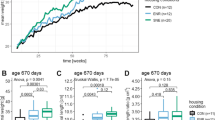Abstract
The design and performance of a fully-climatized environmental chamber for the study of the physiology of conventional or germ-free research animals are described. The chamber temperature can be regulated between 14°–36°C ± 1°C, the humidity between 45–95 ± 2% at 14°C and between 20–95 ± 2% at 36°C. Bilaterally symmetrical lighting is variable over 15 stages between 50–2,400 lux. The performance of the chamber was evaluated in a trial study in which the effect of different chamber temperatures on the O2-consumption of 24 conventional Sprague-Dawley rats held in groups of six to a cage with sexes separate. This showed a mean O2-consumption at 14° to 16°C of 743 ml/(kg·hr), at 18° to 20°C of 653 ml/(kg·hr) at 26° to 28°C of 629 ml/(kg·hr) and at 30° to 32°C of 627 ml/(kg·hr). The differences between O2-consumption at 14° to 16°C and 26° to 28°C and higher were significant (0.05 > p > 0.01).
Zusammenfassung
Konstruktion und Leistung einer vollklimatisierten Kammer zur Untersuchung physiologischer Reaktionen konventioneller sowie keimfreier Versuchstiere auf Umgebungseinflüsse werden beschrieben. Die Kammertemperatur kann zwischen 16° bis 36°C ± 1°C, die Feuchtigkeit zwischen 45–95 ± 2% bei 14°C und zwischen 20–95 ± 2% bei 36°C eingestellt werden. Die symmetrische Beleuchtung ist über 15 Stufen zwischen 0–2.400 Lux veränderlich. Die Eignung der Kammer wurde in einer Arbeit über den Effekt verschiedener Kammertemperaturen auf den O2-Verbrauch bei 24 konventionellen Ratten Sprague-Dawley in Gruppen von sechs in einem Käfig nach Geschlechtern getrennt, geprüft. Der mittlere O2-Verbrauch bei 14° bis 16°C war 743 ml/(kg·Std), bei 18° bis 20°C 653 ml/(kg·Std), bei 26° bis 28°C 629 ml/(kg·Std) und bei 30° bis 32°C 627 ml/(kg·Std). Die Unterschiede sind bei 14° bis 16°C und 26° bis 28°C und höher waren signifikant (0.05> p > 0.01).
Resume
On décrit ici l'agencement et le fonctionnement d'une chambre entièrement climatisée pour l'étude de la physiologie d'animaux conventionnels ou libres de germes. La température peut y être réglée à ± 1°C de 14° à 36°C et l'humidité peut y varier à ± 2% pris entre 45 et 95% à 14°C et entre 20 et 95% à 36°C. Des échairages symétriques placés de part et d'autre de la chambre peuvent êtres allumés selon 15 graduations différentes entre 50 et 2.400 lux. Le fonctionnement de la dite chambre a été mis à l'épreuve lors d'un essai de consommation d'oxygène par différentes températures. L'essai portait sur 24 rats conventionnels de la race Sprague-Dawley placés par groupes de 6 par cage en séparant les sexes. L'essai a montré une consommation de 743 ml/(kg·h) entre 14° et 16°C, de 653 ml/(kg·h) entre 18 et 20°C, de 629 ml/(kg·h) entre 26° et 28°C et de 627 ml/(kg·h) entre 30 et 32°C. La différence de consommation en O2 est signifacative (0.05> p> 0.01) entre 14° à 16°C et 26° à 28°C ou davantage.
Similar content being viewed by others
References
GUSTAFSSON, B.E. (1948): Germ-free rearing of rats. General technique.Acta Pathol. Microbiol. scand. Suppl., 73 : (1/130).
HOOVER, W.H., YOUNG, P.J., SAWYER, M.S. and APGAR, W.P. (1970): Ovine physiological response to elevated ambient carbon dioxide. J.appl.Physiol., 29: 32–35.
JÖCHLE, W. (1963): Umwelteinflüsse auf neuroendokrine Regulationen: Wirkung langfristiger, permanenter Beleuchtung auf jugendliche und erwachsene Ratten. Z.vet.Med. A 10: 653–706.
MOOS, W.S., CLARK, R.K. and KROWN, F. (1965): A precision controlled environmental chamber for studies of the effects of electric fields on biological objects. Int. J. Biometeor., 9: 117–126.
MOOS, W.S., CLARK, R.K., LE VAN, H. and MASON, H.C. (1970): Behaviour and physiology of mice in a closely controlled environment. Int. J. Biometeor., 14: 133–154.
RAY, D.E., ROUBICEK, C.B. and HAMIDI, M. (1968): Organ and gland weights of rats chronically exposed to 22° and 35°C. Growth, 32: 1–12.
REYNIERS, J.A. (1959): Design and operation of apparatus for rearing germ-free animals. Ann. N.Y. Acad.Sci., 78: 47–79.
SHERWOOD, T.C. (1936): The relation of season, sex and weight to the basal metabolism of the albino rat. J. Nutr., 12: 223–236.
TREXLER, P.C. and BARRY, E.D. (1958): Development of inexpensive germ-free animal rearing equipment. Proc. Anim. Care Panel, 8: 75–77.
WEBER, E. (1967): Grundriss der biologischen Statistik. VEB Gustav Fischer Verlag, Jena, 6. Auflage.
WEIHE, W.H., SCHIDLOW, H. and STRITTMATTER, J. (1969): The effect of light intensity on the breeding and development of rats and golden hamsters. Int.J.Biometeor., 13: 69–79.
WOSTMAN, B.S., BRUCKNER-KARDOSS, E. and KNIGHT, P.L. Jr. (1969): Ceacal enlargement, cardiac output and O2-consumption in germ-free rats. Proc.Soc.exp. Biol. (N.Y.), 128: 137–140.
Author information
Authors and Affiliations
Rights and permissions
About this article
Cite this article
Schoen, A. An environmental chamber for the study of the physiology of conventional and germ-free laboratory animals. Int J Biometeorol 16, 173–180 (1972). https://doi.org/10.1007/BF01810288
Received:
Issue Date:
DOI: https://doi.org/10.1007/BF01810288




